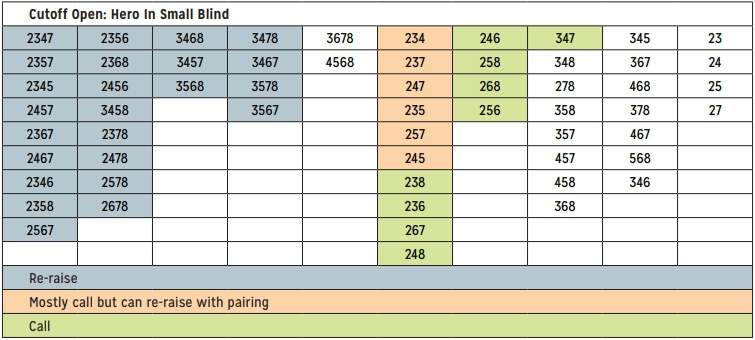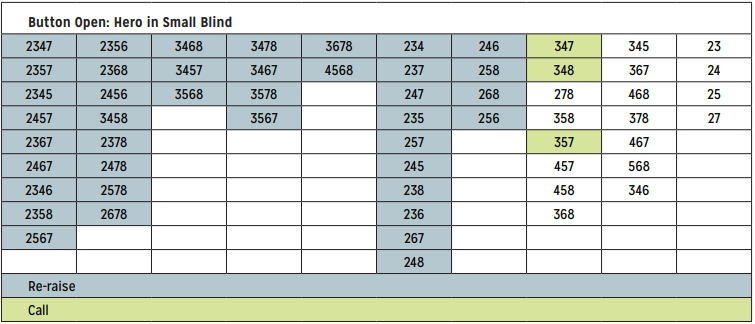






Deuce to Seven Triple Draw Lowball: Small Blind Playby Kevin Haney | Published: Jul 15, 2020 |
|
|
Card Player Magazine, available in print and online, covers poker strategy, poker news, online and casino poker, and poker legislation. Sign up today for a digital subscription to access more than 800 magazine issues and get 26 new issues per year!
The small blind can be a difficult position to navigate in Deuce to Seven Triple Draw Lowball (27TD) as it is many poker variants. We are partly invested in the pot, however, we are out of position and that is a big deal in this game. The big blind may also still get involved and this aspect can further complicate our decisions. In general, playing too loose from the small blind is a common mistake of beginning players.
Folded To Hero In Small Blind
If the action folds around to you in the small blind we should mostly open up our range, although being out of position, we should consider eliminating the very bottom of the holdings. In this regard, we are mostly talking about the roughest two-card draws such as 3-7-8 and 5-6-8 with no blocking pairs.
When everyone folds, the big blind is much more likely to hold a playable hand containing a deuce. And in blind battles even the more passive and straight forward players will tend to get aggressive and put you in difficult situations when you hold the rougher hands that they mostly envision you to have.
Any holding we choose to play should be raised including the three-card draws such as 2-3, 2-4, 2-5, and 2-7. Many players elect to limp in with these holdings and while the decision is close, my preference is to come in with a raise. Holding a deuce slightly reduces the odds our opponent has a hand and when we limp we are often giving out significant equity to holdings that would have folded to a raise.
For example, a lone four has a whopping 45 percent equity against 2-7! While it’s true that when drawing so many cards our opponent will struggle to realize this equity, we are out of position and drawing three, so our own situation is not that great either.
When we get re-raised and our opponent draws two (D2) the situation isn’t that bad as we often have greater than 40 percent equity, we are drawing smooth, and we would have had to call one raise anyway. There are also many D2 holdings that our opponent will not re-raise but would have raised had we limped thus quite often the same amount of money ends up in the pot regardless of our action.
We are only in really bad shape the times our opponent is pat or holds a one card draw (D1) and these hands don’t grow on trees. For the most part coming in for a raise is either very correct or relatively neutral thus it should be our preferred action especially when we hold pairs.
Heads-Up Pots
At a full table we must play tight against a solid early position opener:

As per standard procedure we should re-raise any holding that we plan to play as a one-card draw. Since early position opens are strong with the vast majority of the range containing a deuce our default should be to fold 3-4-6-7, 3-4-7-8, and worse draws.
The 3-4-5-7 is marginally playable because when no one else has entered the pot the remaining deuces may be live and in addition to the absolute nuts we can also make an 8-7-5 low. It’s a fine line between 3-4-5-7 and 3-4-6-7 but the main difference between these two hands is the ability to make an 8-7-5-4-3 as opposed to a much rougher 8-7-6-4-3.
The one-card draws 2-3-7-8 through 2-6-7-8 can be played as D1s, however, all things considered it is probably best to just call and play them as two card draws. These are all very close decisions but if we were going to re-raise and draw one it is better to do with 2-3-7-8 and 2-4-7-8. Those holdings make smoother hands while with the 2-5-7-8 and 2-6-7-8 we gain a lot more in relative potential when we instead draw two and pick up a draw to a seven.
With regards to the two-card draws, we should flat any hand we choose to play and mediocre holdings such as 2-6-8 and 2-5-6 should probably hit the muck. Re-raising premium D2s is overplaying your hand from out of position against a strong early position range.
When an opponent opens from the cutoff their range is typically much looser than from the first two positions. As a percentage of their overall range, there is a much lower concentration of pat and D1 holdings and it is less likely they hold a deuce.
From the first two positions a solid player is around 90-95 percent likely to hold a deuce while from the cutoff position this percentage will often drop below 70 percent.
Loose players will begin to open raggedy two-card draws such as 3-7-8 as well as various three-card draws (D3s).
This will allow us to get involved with more holdings and the default response grid for when the opener originates from the cutoff is as follows:

The first thing to notice here is that we expanded the D1 re-raising range to include hands such as 3-5-7-8 and 3-5-6-7. We can also re-raise our premium D2s in certain situations. If we hold two pair or trips our re-raise is automatic, however, we should consider re-raising even with a single pair especially if it’s deuces against a loose player.
In addition, 2-6-8, 2-5-6, and 3-4-7 were added to the flatting range. The 3-4-7 is marginal in this situation, however, when we catch a deuce our draw is premium and since our opponent is less likely to have one the scale tilts towards playing.
Opening ranges on the button can be really wide; some villains may be in there with hands as bad as 4-5-6, 5-7-8, 3-8, and 4-5. Still, we cannot go overboard in our response because we are out-of-position, we fare quite badly against the upper portion of their range, and the big blind may also get involved. Keeping all of this in mind the default responses against a button open are as follows:

Against a button open we should re-raise any of the listed one-card draws and can also get frisky with holdings such as 4-5-6-9 often turning them into a snow. This play is usually effective versus both loose and tighter players. A loose player will have a larger amount of D3s and often will often be hard pressed to continue on the turn and while a tighter player will have less D3s they are generally more susceptible to snows.
We should also re-raise many D2 holdings even those as marginal as 2-6-8 and 2-5-6. Since the button has the ability to re-raise we may be taking slight the worst of it with a hand like 2-6-8, however, in the aggregate it’s not that bad and eliminating the big blind is highly beneficial.
Hands like 3-4-7, 3-4-8, and 3-5-7 are a little too weak to re-raise but are still too good to fold. Given the relative lack of action the deuces are usually very live and when we catch one our holding can become premium, and the times our smooth-call pulls the big blind into the pot we don’t mind him being around if we improve to strong draws such as 2-3-5-7 or 2-3-4-8.
Three card draws should almost always be folded; the only possible exception being when we hold a hand like 2277 but even that may be too ambitious. If we hold trips of a rank we should consider re-raising and immediately snowing helping balance the times we are dealt a pat hand.
Multi-way Pots
When there is an open from early position followed by a caller or two the pot is getting bigger, however, our chances of winning the hand with a medium holding are usually going down just as fast if not faster. If we hold a deuce we can still play any holding that we would have defended in a heads-up pot but we should not look to expand upon this range.
For example, if the hijack raises and the button calls we should still flat with 2-4-6 and 2-5-8, however, this is not a situation where we should call with more hands such as 2-6-8, 2-5-6, 2-7-8, and weaker because of the larger pot. The problem is that we are out of position to two players with often the worst holding of the bunch. In order to win the hand, we need quite a parlay to come in and we typically have reverse implied odds.
The cold caller is especially likely to have a deuce thus holdings such as 3-4-7 and 3-4-5-7 should be mucked. If instead we have either 3-4-6-8 or 3-5-6-8 we can still put in a re-raise and draw one as we don’t specifically require a deuce to make an 8-6 or better low. However, if there is a raise and a re-raise from early position players it is usually best to make somewhat tight folds with 3-4-6-8 and 3-5-6-8.
When facing a raise and a re-raise our decision on whether or not to continue on with premium D2s is situational. Against a cutoff open and a button re-raise we should cold-call with any of the six premium D2 holdings: 2-3-4, 2-3-7, 2-4-7, 2-3-5, 2-5-7, and 2-4-5. However, facing an under-the-gun open and a hijack re-raise we should be more circumspect especially if the hijack always has a one card draw here. In that particular situation we may only want to continue on with 2-3-4, 2-3-7, and 2-4-7.
Whenever we are in the small blind its okay to take the conservative route and look for reasons to fold. We have the worst position at the table and if our decision is not that clear that is an indication that our holding for the situation is mediocre at best and we are more than likely holding a money loser. ♠
.jpg) Kevin Haney is a former actuary of MetLife but left the corporate job to focus on his passions for poker and fitness. He is co-owner of Elite Fitness Club in Oceanport, NJ and is a certified personal trainer. With regards to poker he got his start way back in 2003 and particularly enjoys taking new players interested in mixed games under his wing and quickly making them proficient in all variants. His new mixed-games website Counting Outs is a great starting resource for a plethora of games ranging from the traditional to the exotic. He can be reached at haneyk612@gmail.com.
Kevin Haney is a former actuary of MetLife but left the corporate job to focus on his passions for poker and fitness. He is co-owner of Elite Fitness Club in Oceanport, NJ and is a certified personal trainer. With regards to poker he got his start way back in 2003 and particularly enjoys taking new players interested in mixed games under his wing and quickly making them proficient in all variants. His new mixed-games website Counting Outs is a great starting resource for a plethora of games ranging from the traditional to the exotic. He can be reached at haneyk612@gmail.com.
Features
The Inside Straight
Strategies & Analysis